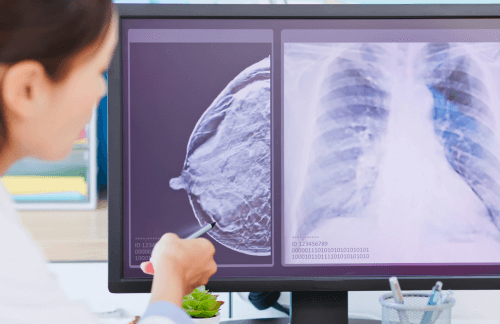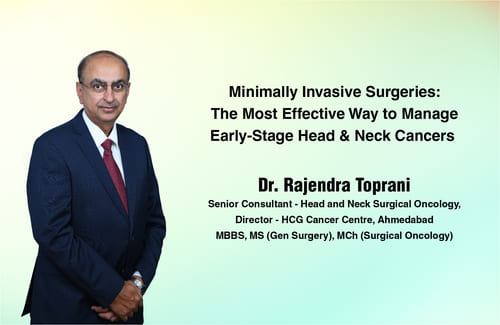What is a Mammogram?
The mammography procedure involves obtaining images of the breast using very low-dose X-rays. The procedure is used to screen and detect breast cancer. The images obtained using mammography tests are known as mammograms. Besides breast cancer, doctors also use mammography to detect benign tumors. Although a mammography test is not a confirmatory test for breast cancer, it may raise sufficient suspicions about the presence of abnormal tissues that require further confirmation through biopsy.
The American Cancer Society recommends mammography every year in women with an increased risk of developing breast cancer, starting typically at the age of 30 years. High-risk women include women with a family history of breast cancer, having BRCA 1 and BRCA 2 mutations, who underwent radiation therapy for other cancers, and having underlying diseases, such as Cowden syndrome, Li-Fraumeni syndrome, and Bannayan-Riley-Ruvalcaba syndrome.
Purpose of Mammogram
The following are the purposes for obtaining a mammogram scan:
-
Screening Mammogram:
A screening mammogram is obtained in women to detect the presence of any abnormal tissues when the women have no signs and symptoms of breast cancer. The screening mammogram scan aims to diagnose breast cancer early to treat it effectively. Screening is especially recommended for women with a high risk of breast cancer. Different healthcare organizations give different recommendations for mammography procedure Baseline mammography is recommended for all women above the age of 40 years. Annual mammography is recommended for all women above 40 years who have a family history of breast cancer.
-
Diagnostic Mammogram:
Diagnostic mammogram is obtained when the patients experience suspicious signs and symptoms that indicate breast cancer. These include breast lumps, nipple discharge, thickening of the nipples, breast pain, and skin alterations of the breast. The unexpected findings of the screening mammogram are comprehensively evaluated through a diagnostic mammogram. While evaluating, the oncologists may require additional mammography images. A breast cancer mammogram detected abnormal tissues detected in the breasts.
What are the Steps of Mammogram Procedure?
Some of the steps of the mammography procedure are:
-
Scheduling and Preparation:
In women with tender or painful breasts, a mammogram should be scheduled 1 to 2 weeks after the pain subsides. Doctors and radiologists should be informed about the presence of breast implants. The women should also provide information about their last menstrual period or pregnancy or breastfeeding before the examination. The women should also follow all the preparation guidelines advised by the doctor and may be asked to leave the jewelry and other valuable things at home.
- Check-in and Information: The women should visit the hospital on the scheduled day and provide detailed information as required by the supporting staff. Before the mammography procedure, they may also undergo other health check-ups, such as blood pressure.
-
Mammogram screening:
Women are asked to stand against a specialized X-ray machine. The breast under examination is placed on a plastic plate. Another plate from the above presses the breast. It results in flattening of the breast while taking the X-ray images. Women may feel mild pressure on their breast. Once one breast is examined, the same procedure is repeated for the other breast. Women may be asked to wait for some time to ensure that the images are clear, and there is no requirement to retake the procedure.
-
Follow-Ups:
A mammogram is evaluated by experts, who specialize in reading and interpreting radiological images. If no abnormal tissue is identified in a mammogram and no further examination is required, one is asked to return at the scheduled date of the next mammography. However, if abnormal tissue is detected, the doctor may advise the individual to undergo further testing, such as a biopsy.
What Does Having a Mammogram Feel Like?
For most women, mammography causes mild discomfort and pain that disappears soon after completion of the procedure. Further, pain and discomfort during mammography depend upon several factors, such as the experience of the technicians, the level of required pressure on the breast, the size of the breasts, and the level of breast sensitivity. Women with menstruation approaching soon may have higher breast sensitivity.
What are the different types of mammograms?
Different types of mammograms include:
-
Screening Mammogram:
The doctor advises a screening mammogram to determine the presence of abnormal tissues in the breast in women with no signs and symptoms of breast cancer or benign tumor. It is especially advised in women with a high risk of breast cancer. The screening mammogram aims to detect cancer early to treat it effectively with a better prognosis.
-
Diagnostic Mammogram:
Diagnostic mammogram is conducted in patients who experience the underlying symptoms of breast cancer, such as a lump in the breast, altered skin of the breast, nipple soreness, nipple discharge, and nipple thickening. A diagnostic mammogram is conducted when the doctor strongly suspects the presence of breast cancer or a benign tumor. Diagnostic mammography may also generate additional breast images besides the mammogram images obtained in screening mammography.
What are the reasons for a mammogram?
There are several reasons for performing mammograms. It may be done for screening or diagnostic purposes. Diagnostic mammography is performed in women >30 years of age if they experience symptoms of breast cancer. Doctors may also advise mammography in women whose physical examination and medical history do not provide conclusive results. Further, certain women with lumpy, dense, and large breasts are also advised for mammography. Women with a high risk of breast cancer are routinely screened with mammography for abnormal tissues.
Who should get a screening mammogram?
Several guidelines recommend that women with no signs or symptoms of breast cancer should also undergo mammography. Most guidelines, such as the American College of Radiology and the U.S. Preventive Services Task Force (USPSTF), recommend that screening mammograms be initiated at 40. Mammography is also recommended for women at increased risk for breast cancer. Women who consume tobacco and alcohol, have obesity, have inherited genetic mutations, have a family history of breast cancer, etc., are categorized as high-risk individuals for breast cancer.
What are the risks of a mammogram?
The following are the risks of a mammogram:
-
Mammograms expose you to low-dose radiation:
During mammograms, women are exposed to low-dose radiation. The benefits of the mammogram outweigh the risks associated with low-dose radiation. However, the women should inform the radiologists if they are pregnant, as radiation might harm the fetus even in low doses. Even if it is necessary to undergo a mammogram, adequate protective measures may be implemented to avoid fetal radiation exposure.
-
A mammogram may result in additional testing:
If the healthcare provider detects abnormal tissue on the mammogram, they may ask the patient to undergo additional tests, such as a biopsy, ultrasound, or MRI.
-
Screening mammography cannot detect all cancers:
Certain breast cancers are so small or present in a specific area that they remain undetected by mammography. It may include cancer of the armpit.
-
Not all cancers found by mammography can be cured:
Mammography is conducted by giving the rationale that the cancers detected on the mammogram are in the early stage and can be effectively treated. However, certain breast cancers are aggressive and quickly spread to other body parts.
How to Prepare for a Mammogram?
One may prepare for the mammogram in the following ways:
-
Schedule the test:
Routine screening mammogram is scheduled depending on the age of the individual and the degree of risk of breast cancer they carry. Diagnostic mammography is scheduled after a comprehensive evaluation of the signs and symptoms experienced by women, and the doctor is suspicious about the presence of abnormal tissues.
-
Bring your prior mammogram images:
During every subsequent mammogram, women are advised to carry the mammograms of prior mammography. It will assist the radiologists in tissue alterations during prior and current mammography.
-
Do not use deodorant before your mammogram:
The patients are advised to avoid using lotions, deodorants, antiperspirants, perfumes, or creams on the breasts and under the armpits. The metallic particles in these products may be seen on the mammograms and interfere with the results.
Why Choose HCG Borivali Cancer Center for Mammogram Procedure?
HCG Borivali Cancer Center offers advanced mammography services for screening and diagnostic purposes. The center is equipped with advanced digital mammography techniques. Several other technologies, such as an automated Breast Volume Scanner (ABVS), are available at the center for detecting breast cancer. Furthermore, the radiologists, breast oncologists, and staff involved in mammography are experienced and technically sound in performing comfortable and smooth mammography procedures.
Conclusion
Mammography is a procedure of obtaining X-ray images of the breasts to detect the presence of any abnormal growth. It is performed for both screening and diagnostic purposes. The early-stage breast cancer mammogram can detect cancerous tissues even when the patients experience no symptoms. Screening mammograms are found to be highly efficient in women who identify as high-risk individuals. As it involves exposure to low-dose radiation, women should inform about their pregnancy before mammography. This is important for doctors to ensure that the benefits associated with mammography outweigh the risks.
Frequently Asked Questions
- Are mammograms safe?
Several patients ask about the mammography test and its safety. Mammography is usually safe, and women undergoing mammography are exposed to a small amount of radiation. However, adequate safety measures should be followed in pregnant women undergoing mandatory diagnostic mammography.
- Do Men Get Mammograms?
Men have fewer breast tissues, and the procedure is ineffective in fewer tissues. Thus, men usually do not undergo mammograms. However, doctors may recommend mammograms in men with a high risk of breast cancer because of an underlying genetic mutation.
- What are the limitations of mammography?
Limitations of mammography tests include radiation exposure, overdiagnosis, overtreatment, and false positive and negative results. Further, mammography tests are not helpful to all women and may not detect very small cancer tissues.
- How accurate is mammography?
Screening mammograms is effective in diagnosing breast cancer, especially in women >50 years of age. The sensitivity rate of mammogram screening is about 87%.
- How long does a mammogram take?
The duration of a mammogram may vary depending on the purpose. While a screening mammogram takes about 15 to 20 minutes, a diagnostic mammogram takes longer due to additional images.
- What are the signs of breast cancer on a mammogram?
Breast cancer tissues on a mammogram are like white specks, while fatty tissues look black on a mammogram. Signs of a stage 1 breast cancer mammogram may be different from stage 4 breast cancer mammogram.
- Can all breast cancer be detected by mammograms?
Not all breast cancers are detected by the mammogram. Cancers that are too small or are present in an area that is hard to scan cannot be detected by a mammography test.
- What is a normal mammogram result?
In normal mammography tests, the doctors do not detect any white specks, asymmetry, calcifications, masses, and other abnormalities.


